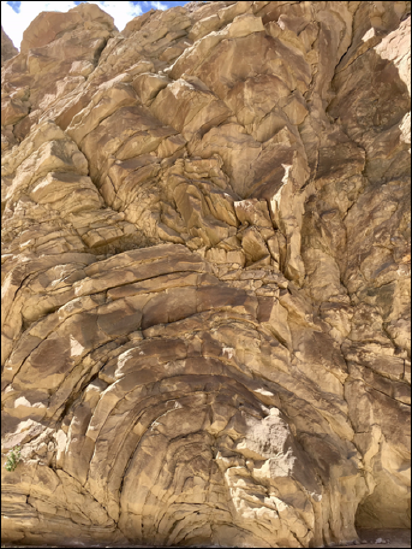15.4: Activity 15C - Geologic Structure Identification
- Page ID
- 14854
1. Identify the geologic structure in Figure 15.30 below, and the stress which formed it.
a. Structure Name:
b. Stress:

2. Identify the geologic structure in Figure 15.31 below, and the stress which formed it.
a. Structure Name:
b. Stress:

3. Identify the geologic structure in Figure 15.32 below, and the stress which formed it.
a. Structure Name:
b. Stress:

4. Identify the geologic structure in Figure 15.33 below, and the stress which formed it.
a. Structure Name:
b. Stress:

5. Identify the geologic structure in Figure 15.34 below, and the stress which formed it.
a. Structure Name:
b. Stress:

6. Identify the geologic structure in the cross-sectional view (Figure 15.35) below, and the stress which formed it.
a. Structure Name:
b. Stress:

7. Identify the geologic structure in the map-view (Figure 15.36) below, and the stress which formed it.
a. Structure Name:
b. Stress:

8. Identify the geologic structure(s) in Figure 15.37 below, and the stress which formed it.
a. Structure Name:
b. Stress:

9. Identify the geologic structure(s) in Figure 15.38 below, and the stress which formed it.
a. Structure Name:
b. Stress:

10. Identify the geologic structure(s) in the cross-section (Figure 15.39) below, and the stress which formed it.
a. Structure Name:
b. Stress:

Attributions
- Figure 15.30: Derivative “Geologic Map of North America” (Public Domain; USGS) by Chloe Branciforte
- Figure 15.31: “Strike-slip Fault 1” (CC-BY 4.0; Chloe Branciforte, own work)
- Figure 15.32: “Fold in Maryland” (CC-BY-SA 3.0; Acroterion via Wikimedia Commons)
- Figure 15.33: Derivative “Geologic Map of North America” (Public Domain; USGS) by Chloe Branciforte
- Figure 15.34: “Strike-slip Fault 2” (CC-BY 4.0; Chloe Branciforte, own work)
- Figure 15.35: “Split Mountain Gorge Fold in Anza-Borrego Desert State Park” (CC-BY-SA 4.0; Robert Arends via Wikimedia Commons)
- Figure 15.36: “Richat Structure” (Public Domain; NASA)
- Figure 15.37: Derivative of “Folded Ordovician Limestones” (CC-BY 2.0; James St. John via Flickr) by Chloe Branciforte
- Figure 15.38: “Faults, Volcanic Glass, and Tuff” (CC-BY-SA 2.0; Penny Higgins via Flickr)
- Figure 15.39: “Fault in Gyprock” (CC-BY 2.0; James St. John via Flickr)


